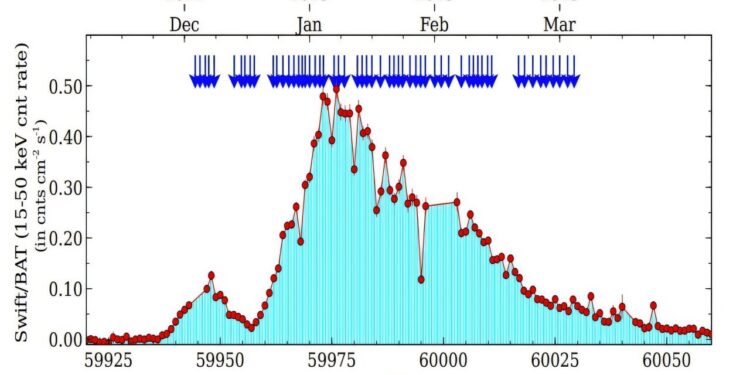The SWIFT / Long-term BAT LIGHT CURB OF RX J0440.9 + 4431 EN 15-50 KEV covering the giant lighting duration 2022-2023. The arrows of the inserts in the figure represent the beginning of the sharp observations of RX J0440.9 + 4431 carried out with insight-hxmt. The error bars represent 1σ uncertainty. Credit: arxiv (2025). DOI: 10.48550 / Arxiv.2507.18676
Astronomers at Wuhan University in China used the Insight-Hxmt satellite to observe a giant explosion that occurred in RX RX J0440.9 + 4431 X-ray about three years ago. Observations results, presented on July 24 on the pre-printed server arxivProvide a multitude of data concerning the properties and behavior of this system.
Binaries with X -rays (XRB) are a class of binary stars luminous in X -rays. They are composed of a normal star or a white dwarf transferring the mass to a compact neutron star or a black hole. Based on the mass of the companion star, these systems can be divided into binary X -ray binary (LMXB) and binary X -ray binary (HMXB).
X-ray binaries (Bexrbs) are one of the HMXBS subclass in which the optical star is a dwarf, subdigent or giant OBE star. The detection and study of the X -ray explosions of Bexrbs could be essential in order to improve our understanding of the nature of the binary X -rays and their behavior.
RX J0440.9 + 4431 is a BEXRB discovered in 1997 with its LS +44 17 / BSD 24-491 optical companion, during the Galactic Rosat survey. The system, which houses a pulsar, is located around 8,000 light years and has X-ray pulsations with a period of 202.5 seconds.
At the end of December 2022, a giant explosion of RX J0440.9 + 4431 began, which lasted until March 2023. Prahlad R. Epili from the University of Wuhan and Wei Wang decided to observe the lighting with Insight-Hxmt, hoping to bring more light on the spectral variability and at the time of this binary.
“The Insight-Hxmt observed this source in several cases of the entire explosion in 2022-2023. We used these brilliant lighting observations of the pulsar to study its spectral variability and synchronization of X-rays”, the researchers wrote in the article.
Observations have revealed that the impulse profiles during the progress and decline phases of the 2022-2023 collapse in similar luminoses show similar variations in shape. This indicates a strong brightness dependence of the impulses in RX J0440.9 + 4431.
The light X -ray brightness of the pulsar in RX J0440.9 + 4431 during the radiance covered in the range of 4.4–28 Uncillion Erg / s in 1 to 120 Kev. Astronomers have noted that the spectra means by the pulsar phase in 1 to 120 KEV can be explained with a model of cutting up cutting power.
In addition, hard X -ray observations with high cadence of the pulsar reveal the presence of a variable diffusion characteristic of the Cyclotron resonance (CRSF) in the energies of (33.6–41.6) Kev. During the drop in the phases of the giant explosion, the researchers identified a second line of cyclotron varying in the beach of approximately 64.6–75.3 KEV.
The study also revealed that pulsar in RX J0440.9 + 4431 has a relatively strong magnetic field. It varies throughout the explosion, between 4.8 and 15.4 Billions of Gauss.
Written for you by our author Tomasz Nowakowski, edited by Sadie Harley, and verified and examined by Robert Egan – This article is the result of meticulous human work. We are counting on readers like you to keep independent scientific journalism alive. If this report matters to you, please consider a donation (especially monthly). You will get a without advertising count as a thank you.
More information:
Prahlad R. Epili et al, Insight-Hxmt Spectral and Timing Studies of a giant explosion in RX J0440.9 + 4431, arxiv (2025). DOI: 10.48550 / Arxiv.2507.18676
Newspaper information:
arxiv
© 2025 Science X Network
Quote: Astronomers observe a giant explosion of binary radiography RX J0440.9 + 4431 (2025, August 4) recovered on August 5, 2025 from
This document is subject to copyright. In addition to any fair program for private or research purposes, no part can be reproduced without written authorization. The content is provided only for information purposes.



